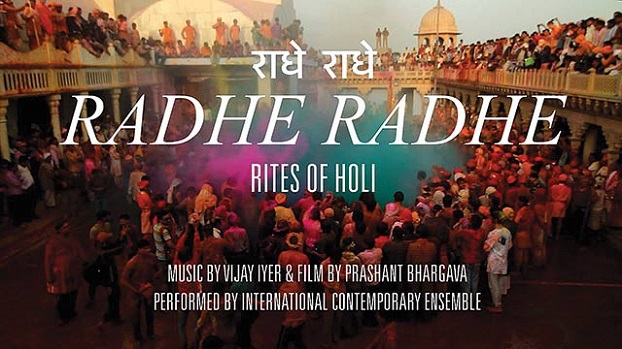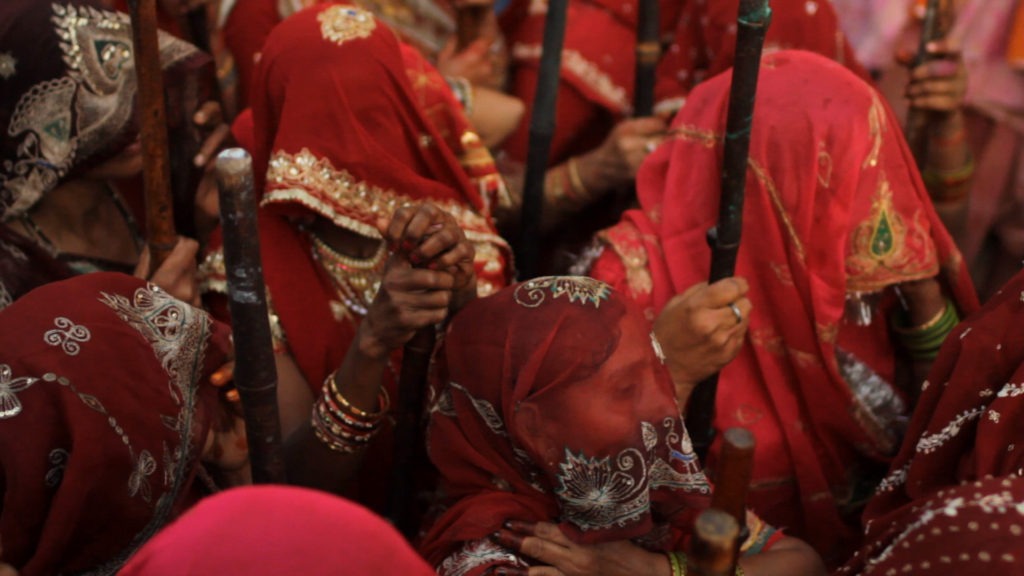
In the absence of a plane ticket to North Carolina, one must kick the imagination into gear to experience the splendor of the spring celebration that will fill the Carolina Performing Arts Center tonight.
A 14-by-26 foot screen will flash scenes from a heartland: Holi, the Indian festival of colors, being observed in Braj, the mythic birthplace of the Hindu god Krishna.
In the air, the swells of a 10-piece orchestra, playing the original score that was composed to accompany these scenes.
Then imagine (why not?) the names on a fantasy marquee: Stravinsky, Radha, Bhargava, Iyer.
Those last two are filmmaker Prashant Bhargava and composer/pianist Vijay Iyer, the contemporary and earthly creative forces behind “Radhe Radhe,” a filmic, musical meditation on Igor Stravinsky’s 1913 ballet, “The Rite of Spring.”
But if you’re not there for the premiere of “Radhe Radhe,” you’ve missed the only performance of the piece for the foreseeable future. Carolina Performing Arts commissioned the trans-format work as part of its centennial commemoration of The Rite of Spring, and composer Iyer approached Bhargava, who directed last year’s critically acclaimed Patang, to collaborate with him on the work. Initially, they explored the idea of filming Holi celebrations in Queens, Bhargava said.
“I was like no, we can’t do that. We have to go to where it’s really celebrated. In Mathura, Krishna’s birthplace and Radha’s playground.”
Which is how Bhargava ended up filming in Uttar Pradesh during eight days of boisterous worship of the goddess Radha, and depicting the tale of her love affair with Krishna. He edited his story to Stravinsky’s music, and then handed the visuals and ambient sound off to Iyer to compose the score.
Shortly before the pair’s first rehearsal last week, Bhargava spoke to me about the professional and personal twists and turns of the project.
NK: What was the story that you were envisioning you wanted to tell, besides what unfurls there naturally? How much of it was scripted?
PB: I began with Stravinsky’s piece. The original piece is broken up into 12 sections — I began with those.
I was a little bit confused, though. Because everything I had experienced with Holi was quite joyous. It was just throwing color and having fun. But this was a very dark piece. I knew it needed to have an arc, it needed to have a journey, it couldn’t just be all brightness.
When I was (in Braj), it felt like the Bible Belt or something. There was such a fanaticism for Radha and Krishna that it felt uncomfortable at first. Then I got into it. It was really something I never expected.
NK: Did you have a sense that they were accustomed to a lot of people filming, where you were?
PB: Actually, a lot of people were there with much more gear (than we carried). They’re used to filmmakers being around. It’s such a spectacle.
NK: So they don’t trip when a camera crew is among them.
PB: I think we were eventually able to create a vision and get in, in a way that I haven’t seen before with footage. It might be our own sensibilities. I really believe it was the relationships that were created immediately, in a very short time.
NK: Can you give me an example?
PB: This is a light thing. But, for example, most commonly it’s a very male-oriented event, though the event affects everyone. Who you see out and acting like idiots, it’s usually males, expressing their sexual energy by being perverse, and stuff.
One thing that I would always see there was these big, almost like mosh pits, this dancing, with a lot of males. So I would immediately run into the middle. And when you’re in the middle, you’ll become a target, because they’re like, “What are you doing here?”
And then they’ll push you, throw heavy, heavy color straight at your camera. And I’ll take it, push back, and I’ll start dancing, or whatever I needed to do. And then they’d start laughing and right away, within a couple of moments, everyone just lets you do whatever. Because you take it and enjoy it. If you’re running around and someone throws color at you and you resist, oh, they’re gonna come at you more.
So the dancing was a basic level.
NK: How would you sum up the story that you told?
PB: What I heard over and over there, was the term Radhe Radhe. That was a term to greet someone, that was a term that you would use when you bumped into someone. I really began to think of that and do some exploration.
In the broader concept of things, Radha is a married woman who has spent some time with Krishna, and it’s the most ecstatic, joyous thing she ever experienced in her life. She’s portrayed as this woman who’s always longing for him, and she writes these very sad poems, and is jealous and angry when he’s gettin’ with all the other girls, and stuff.
Then I started to see that there was another way that their union was the embodiment of this pure sexual energy in the most beautiful form. There are some people that worship Radha as almost the gateway to Krishna, look at Krishna as if he is someone who’s building the castle, and she’s the real queen. And in fact, the only temple in India that features Radha alone is in that region that we were in.
And then there’s this whole other thing where the men from Krishna’s playground venture to Radha’s playground … by drinking lots of bhang, and coming in with such bravado. They come in, and they go to the temple, and they sit down in front of the other men. They taunt each other with very crude sexual stuff, and that’s when all the buckets are coming down.
They go down into the village and the women there are waiting with these long, long sticks. And the men, from 10-year-old boys all the way up to 70-year-old men, are screaming nasty, nasty stuff. And the priest will come to you and tell you, “This is the peak sexual energy, this is what we should be doing.” You’re like, “This is — there’s just something wrong with this.”
So, this day is the only day that the women can really get some revenge. I wish they could just pure beat (the men). They use these small leather shields. Then you have like 10, 15 women just beating on these shields. The way that they’re beating is with such animosity and anger.
It’s so cathartic, you can tell that these regions are really affected by some bad, bad situations of domestic violence and abuse. And that this is the one time the women get to let it all out.
NK: Did you expect that?
PB: I didn’t know it was going to be like that. So when I came back, and I started thinking about it, I was like, this should be a piece about the citywide devotion to Radha and the journey of trying to get close to her spirit. And how that affects you in terms of your relation and exuberance and ecstatic-ness, and transformation.
So I’ve structured each chapter like The Rite of Spring in terms of their names: “We’re Preparing For Her Arrival,” “We’re Eagerly Awaiting Her Arrival,” “Punish Me, I’m Yours, Radha.” When I started to come up with the very actor-driven objectives in a sexualized kind of tone of what you would do for your lover, that’s how I started editing the piece, and that became the journey of the sexualized devotion to Radha.
I think the audience will really feel that — this is really a journey from winter to spring, by letting all of this very primal energy that’s been cooped up, out.
NK: So when you were there, in the middle of this heightened scene, how did your own religious connection come into it? Or impact your experience as a filmmaker who was inside of a story to a degree you hadn’t been previously?
PB: I would say at a much deeper level. The belief is stronger in a way. But the kite festival (depicted in Patang), was also a change of seasons. It marked when the wind direction changes. And every time I was at that festival, there was something very genuine that happened in my own life at some point during that day.
Read more about “Radhe Radhe: Rites of Holi” (PDF) courtesy of Carolina Performing Arts Center.
You can follow Nishat Kurwa on Twitter @nishatjaan.












